| Pages:
1
2 |
markx
National Hazard
   
Posts: 646
Registered: 7-8-2003
Location: Northern kingdom
Member Is Offline
Mood: Very Jolly
|
|
Simple shielded lever press
Any attempts to in depth investigations in the field of energetics cry out for the help of an appropriate pressing device. I have seen and heard of
some pretty horrendous practices being executed regarding this matter...starting from unshielded bench vise and ending with a charge being hammered
into containment. So in hopes of setting a humble example in a more appropropriate direction (far from perfect though) I went forth and constructed a
simple shielded lever press. Perhaps it can serve as an inspiration to fellow experimenters involved in the field:
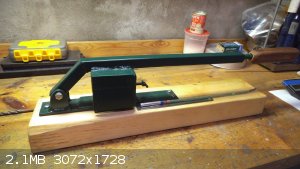 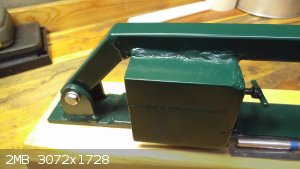 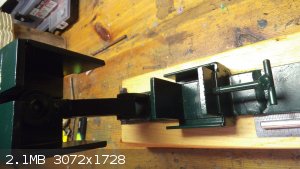 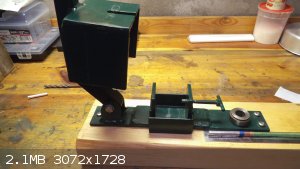 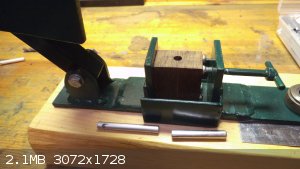 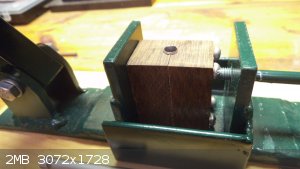 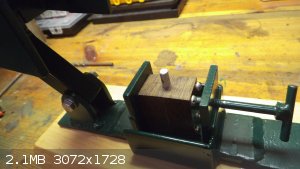 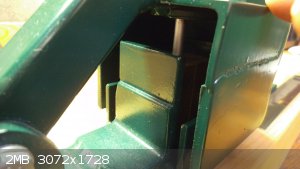
As can be seen on the pictures, the whole pressing assembly is enclosed in a steel barricade that shields the user from the worst primary shrapnel
effects and directs the energy out the front of the device in case of a mishap. Granted, one can still recieve an injury, but at least the energy can
be partly dissipated and redirected by the simple shielding. Please feel free to share your ideas on how to improve the design...
Exact science is a figment of imagination.......
|
|
|
APO
National Hazard
   
Posts: 627
Registered: 28-12-2012
Location: China Lake
Member Is Offline
Mood: Refluxing
|
|
Very nice work markx.
"Damn it George! I told you not to drop me!"
|
|
|
Bert
Super Administrator
        
Posts: 2821
Registered: 12-3-2004
Member Is Offline
Mood: " I think we are all going to die. I think that love is an illusion. We are flawed, my darling".
|
|
Excellent. The BEST time to think about safty equipment is BEFORE the accident!
A load cell under the loading block assembly or other means to calibrate force applied would be a useful feature.
Rapopart’s Rules for critical commentary:
1. Attempt to re-express your target’s position so clearly, vividly and fairly that your target says: “Thanks, I wish I’d thought of putting it
that way.”
2. List any points of agreement (especially if they are not matters of general or widespread agreement).
3. Mention anything you have learned from your target.
4. Only then are you permitted to say so much as a word of rebuttal or criticism.
Anatol Rapoport was a Russian-born American mathematical psychologist (1911-2007).
|
|
|
markx
National Hazard
   
Posts: 646
Registered: 7-8-2003
Location: Northern kingdom
Member Is Offline
Mood: Very Jolly
|
|
Quote: Originally posted by Bert  | Excellent. The BEST time to think about safty equipment is BEFORE the accident!
A load cell under the loading block assembly or other means to calibrate force applied would be a useful feature. |
A load cell would be a very useful upgrade...I've been thinking about this option myself, but have not found a reasonably simple and affordable means
to realise it so far. Instead I opted for a set of precalibrated loading pins to get desired compaction rates. The action of the press is limited by
the shield touching the base and hence always stops at the same height from the base of the load compartment. Therefore the density can be regulated
with either the lenght of the loading pin (if charge mass is kept constant) or the charge mass (if loading pin lenght is kept constant). I suspect the
option where charge mass is kept constant is preferable for comparative reasons and a matching set of loading pins is an easy and dirt cheap option to
realise. It just involves the ability to solve a simple equation system and a stock of round bar of choice (hardwood is preferable, I would avoid
metal as far as possible):
V=3,14* r2 *h
V=m/density
L=H-h
Where r is the radius of the load, V is the volume of the load after pressing, h is the height of the load after pressing, m is the mass of the load,
density being the desired compaction after pressing, H being the height of the loading compartment in fully closed position of the press and hence L
being the required load pin lenght.
By choosing the desired mass and density of the charge, one can simply calculate the loading pin lenght. For a particular mass/density combination the
pin is universal and can be used for different substances. That is if the applied force is strong enough to drive the press to a fully closed
position....common sense and selfpresevation instinct should be the user's best allies at that point 
P.S. I strongly advise against the pressing of primaries on top or the secondary to create a joint compound device. Apart from suicidal danger levels
this practice seems to give surprisingly bad results as far as primary material economy goes with SADS. I have not tested on other primaries, but
small scale tinkering with PETN SADS combo gave frustrating failures at even the ratio of 0,8/1 of sads/petn by mass with PETN density of 1,2g/cm3.
Simply put, 80mg of best quality double salt was unable to initiate 100mg base charge and kept persistantly pulverising it. For comparison, 40mg of
the same primary on separate carrier with some loose base inbetween the secondary and primary carriers gave confident initiation every time....makes
one wonder.
[Edited on 29-9-2014 by markx]
Exact science is a figment of imagination.......
|
|
|
markx
National Hazard
   
Posts: 646
Registered: 7-8-2003
Location: Northern kingdom
Member Is Offline
Mood: Very Jolly
|
|
A small additional feature to go with the press for constructing separate primary carriers...again, perhaps for inspirational purposes:
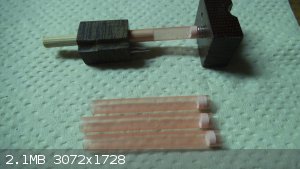 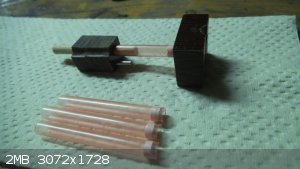 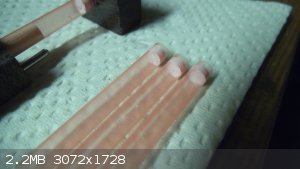
The snapshots portray 75mg SADS units to go with secondary carriers of choice. I could actually use less primary material per unit, but for the sake
of structural integrity with that particular diameter (4,5mm) the 75mg was about the minimum that could be used without the disc becoming too thin and
structurally unstable. Notice the wooden loading pin....I would strongly discourage the use of any metals pins in primary compacting practice.
[Edited on 29-9-2014 by markx]
Exact science is a figment of imagination.......
|
|
|
roXefeller
Hazard to Others
  
Posts: 463
Registered: 9-9-2013
Location: 13 Colonies
Member Is Offline
Mood: 220 221 whatever it takes
|
|
Given your postscript in the earlier post regarding economy of SADS, what do your secondary carriers look like alone and assembled with the primary
carriers?
|
|
|
markx
National Hazard
   
Posts: 646
Registered: 7-8-2003
Location: Northern kingdom
Member Is Offline
Mood: Very Jolly
|
|
Quote: Originally posted by roXefeller  | | Given your postscript in the earlier post regarding economy of SADS, what do your secondary carriers look like alone and assembled with the primary
carriers? |
You can see one assembled unit on first picture on top of the press base (it is acutally a dummy unit with no charge in it). I constructed it with
inert materials to check the functionality of assembly procedure. The fuse is inserted into the primary carrier and fixed with pvc tape. I usually add
a plastic straw that the fuse extends through....for convenience of handling. The secondary carrier is the foil tube with the main charge pressed into
it. One can also be seen on the press pictures beside the loading pin.
In earlier design I had the primary carrier filled with a pyrotechnic delay mixture for added structural integrity. Then a part of the delay was
removed from the end of the tube and replaced by a quantity of primary. It allowed to vary the primary charge mass with no limitations. The downside
was complicated and time consuming assembly...just way too much tinkering around with small things. To be honest, the hollow design is not very
sustainable against mechanical influence and it does not allow the charge mass to be much below 75mg without falling apart. So I guess I will have to
find a suitable delay mixture that I can press into the primary carriers hollow part after the energetic...this would add structural integrity and
again allow for smaller amounts of primary to be applied with basically no limitations and still be quicker to assemble. Any ideas on what kind of
delay mixture would be the best for this application? I have used the rocket candy type of mix with iron oxide as catalyst before, it performed pretty
good, but perhaps someone has a better proposition...
[Edited on 30-9-2014 by markx]
Exact science is a figment of imagination.......
|
|
|
Praxichys
International Hazard
    
Posts: 1063
Registered: 31-7-2013
Location: Detroit, Michigan, USA
Member Is Offline
Mood: Coprecipitated
|
|
Excellent work! How did you make the foil tube? They look very uniform. I had assumed up until I read your last post that you had found some sort of
casing that is perfectly suited for the job. I have been looking for deep-drawn brass or aluminum casings for a long time.
|
|
|
markx
National Hazard
   
Posts: 646
Registered: 7-8-2003
Location: Northern kingdom
Member Is Offline
Mood: Very Jolly
|
|
Quote: Originally posted by Praxichys  | | Excellent work! How did you make the foil tube? They look very uniform. I had assumed up until I read your last post that you had found some sort of
casing that is perfectly suited for the job. I have been looking for deep-drawn brass or aluminum casings for a long time. |
Yeah....no luck with finding suitable prefabricated casings. I have seen some deep drawn sample holder cases for chemical analysis apparatus, but
these cost an arm and a leg and are not of suitable dimensions. Best bet is to roll your own and it is really simple. Just cut strips of heavy foil,
roll around a loading pin of suitable dimensions, crimp the end and place into end forming cavity, tap with a hammer and slide the case off the pin.
Sure it takes some time to tinker with this, but I find that it is the simplest and easiest way to do it. Best part is that you have the possibility
to choose any dimesions needed and can design all parts to fit together properly from the beginning on.
Exact science is a figment of imagination.......
|
|
|
Bert
Super Administrator
        
Posts: 2821
Registered: 12-3-2004
Member Is Offline
Mood: " I think we are all going to die. I think that love is an illusion. We are flawed, my darling".
|
|
If chemical compatibility with Copper is not an issue-
Many sizes of ready made swaged Copper cups
Rapopart’s Rules for critical commentary:
1. Attempt to re-express your target’s position so clearly, vividly and fairly that your target says: “Thanks, I wish I’d thought of putting it
that way.”
2. List any points of agreement (especially if they are not matters of general or widespread agreement).
3. Mention anything you have learned from your target.
4. Only then are you permitted to say so much as a word of rebuttal or criticism.
Anatol Rapoport was a Russian-born American mathematical psychologist (1911-2007).
|
|
|
Praxichys
International Hazard
    
Posts: 1063
Registered: 31-7-2013
Location: Detroit, Michigan, USA
Member Is Offline
Mood: Coprecipitated
|
|
Wow Bert, that is an excellent find... but you took me on an awesome online shopping journey ending in these wonderful things:
http://www.aliexpress.com/item/50pcs-lot-Thermocouple-RTD-6-...
http://www.aliexpress.com/item/20pcs-lot-Thermocouple-RTD-DS...
http://www.aliexpress.com/item/Free-shipping-Thermocouple-RT...
Perfect stainless steel initiator casings! Cheap and just the right size. They come in all shapes and sizes but I have yet to find a US supplier. Free
shipping from China at the ~$0.60/pc level.
|
|
|
markx
National Hazard
   
Posts: 646
Registered: 7-8-2003
Location: Northern kingdom
Member Is Offline
Mood: Very Jolly
|
|
Them stainless tubes look really excellent! But seem quite thick walled...accidental shrapnel from something like that can be very hard to contain.
Even with a metal shield.
Exact science is a figment of imagination.......
|
|
|
Bert
Super Administrator
        
Posts: 2821
Registered: 12-3-2004
Member Is Offline
Mood: " I think we are all going to die. I think that love is an illusion. We are flawed, my darling".
|
|
The stainless steel capsules are pretty- Maybe a little short and narrow, but look nice. I might order some for use in fabricating movie props! But
not for actual use, I see a couple of problems there.
Stainless steel is a hard, tough material. Fuses or electric match head installation requires crimping the mouth of the capsule- This material might
well be harder than a standard non sparking fuse cutter/cap crimper.
The thermocouple capsules are 6mm OD and unspecified ID, in my experience 6mm OD capsules will not be sufficient ID for crimped in standard 1/4" fuse,
and is marginal for the "shroud" of commercial electric matches-
It is usual for capsules to be formed with a concave profile at the base charge end. With Copper or Aluminum, this contour may easily be pressed in.
Stainless steel, probably not so easy!
When using markx's device, it might be sufficient to place an appropriately sized ball bearing in the bottom of the capsule holder before pressing
the base charge into the capsule. Sufficient pressure to consolidate such base charges as PETN/RDX/MHN to maximum practical density could result in a
nice hemispherical concavity at the output end of a soft copper capsule, and most probably in Aluminum- Thus producing Munroe effect at final
output... Don't leave anything on the table, get every bit of performance you can out of your initiator!
Rapopart’s Rules for critical commentary:
1. Attempt to re-express your target’s position so clearly, vividly and fairly that your target says: “Thanks, I wish I’d thought of putting it
that way.”
2. List any points of agreement (especially if they are not matters of general or widespread agreement).
3. Mention anything you have learned from your target.
4. Only then are you permitted to say so much as a word of rebuttal or criticism.
Anatol Rapoport was a Russian-born American mathematical psychologist (1911-2007).
|
|
|
markx
National Hazard
   
Posts: 646
Registered: 7-8-2003
Location: Northern kingdom
Member Is Offline
Mood: Very Jolly
|
|
I was just thinking about the possibility of inducing Munroe effect in the primary carrier stage....perhaps changing the contour of the straw holder
base to a hemisphere or conical geometry would allow for a shaped charge like effect in the primary stage, thus giving better initatiation ability and
perhaps even material economy. So much testing to do....so little time!
Exact science is a figment of imagination.......
|
|
|
Laboratory of Liptakov
International Hazard
    
Posts: 1387
Registered: 2-9-2014
Location: Technion Haifa
Member Is Offline
Mood: old jew
|
|
load
Do you think something like that? Also, think about it. In research detonators type NPED.
LL
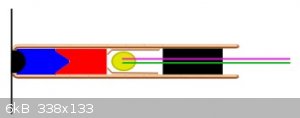
|
|
|
markx
National Hazard
   
Posts: 646
Registered: 7-8-2003
Location: Northern kingdom
Member Is Offline
Mood: Very Jolly
|
|
| Quote: |
Do you think something like that? Also, think about it. In research detonators type NPED.
LL
|
Well, yes, something along these lines....
I guess with initiation systems the goal is to make it simple, reliable and safe. The cruel reality of the "Great Architect" seemingly lets us choose
only any two options out of the three.
Simple and reliable: with primaries....not safe
Simple and safe: NPED designs...not reliable
Safe and reliable: Bridgewire systems...not quite so simple
But I always try to find joy in attempting 
Exact science is a figment of imagination.......
|
|
|
Laboratory of Liptakov
International Hazard
    
Posts: 1387
Registered: 2-9-2014
Location: Technion Haifa
Member Is Offline
Mood: old jew
|
|
NPED
Safe and Reliable and simple detonator: This is the Holy Grail of fireworks. Way to the Holy Grail is a big challenge. Secondary and tertiary
explosives have long been a safe, reliable and simple. (some) Detonator not. Detonator is key. I'm working on it for 2 years. I am at the stage: Very
simple and safe.
LL
|
|
|
Energetic Einstein
Harmless

Posts: 12
Registered: 10-1-2014
Member Is Offline
Mood: No Mood
|
|
Quote: Originally posted by Laboratory of Liptakov  |
Safe and Reliable and simple detonator: This is the Holy Grail of fireworks. Way to the Holy Grail is a big challenge. Secondary and tertiary
explosives have long been a safe, reliable and simple. (some) Detonator not. Detonator is key. I'm working on it for 2 years. I am at the stage: Very
simple and safe.
LL |
Maybe you should create or post on a NPED thread on your findings. That way it doesn't clutter this thread. Also a design can sound good in your head.
Its when you put it on paper, and present the paper to those who have a greater knowledge on that topic; Is when you find the positive and negatives
about your design.
|
|
|
roXefeller
Hazard to Others
  
Posts: 463
Registered: 9-9-2013
Location: 13 Colonies
Member Is Offline
Mood: 220 221 whatever it takes
|
|
He did post about it, at least enough to tease without disclosing enough to criticize. He seems to assert that he's found the holy grail without showing
it. Maybe we can goad him into talking. 
|
|
|
Bert
Super Administrator
        
Posts: 2821
Registered: 12-3-2004
Member Is Offline
Mood: " I think we are all going to die. I think that love is an illusion. We are flawed, my darling".
|
|
Do we want to start an NPED/blasting cap design thread?
If someone wants to organize their information, document references and kick off a new thread, I would be happy to edit the appropriate posts of this
thread into it- Or merge them with one of the existing NPED threads.
Both topics (safety in pressing, NPED cap design) are EXCELLENT places for members to put in some research. They are related... But should have their
own threads, for the sake of simplicity in accessing their information. Too many long, tangled threads here already!
[Edited on 3-10-2014 by Bert]
Rapopart’s Rules for critical commentary:
1. Attempt to re-express your target’s position so clearly, vividly and fairly that your target says: “Thanks, I wish I’d thought of putting it
that way.”
2. List any points of agreement (especially if they are not matters of general or widespread agreement).
3. Mention anything you have learned from your target.
4. Only then are you permitted to say so much as a word of rebuttal or criticism.
Anatol Rapoport was a Russian-born American mathematical psychologist (1911-2007).
|
|
|
markx
National Hazard
   
Posts: 646
Registered: 7-8-2003
Location: Northern kingdom
Member Is Offline
Mood: Very Jolly
|
|
I was bored to go out and perform the pointless spring chase after girls this past weekend and decided to relax and tinker about in my workshop a
little instead of throwing time and money into the wind and across the bar in the night clubs. Conceived a fuse/cord/tube cutter for the purpose of
making primary carrier cases and other energetics related contraptions:
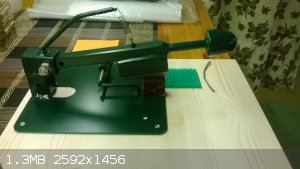 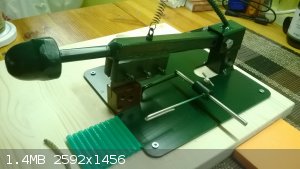 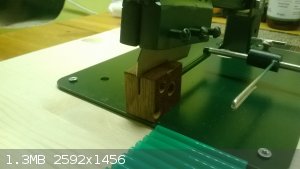 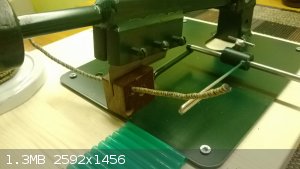 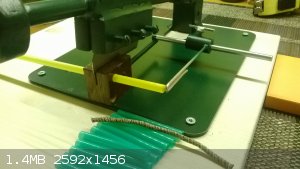 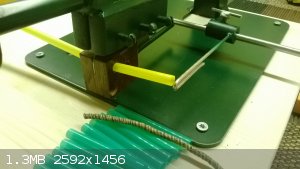 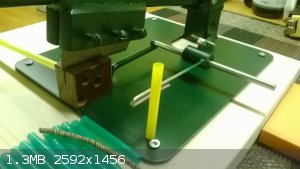 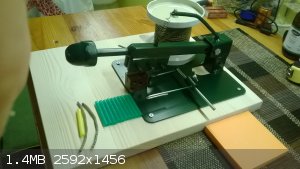
LOL...this has to be the most "dildoesque" piece of equipment that I have ever come up with  
But it rather appeals to my distorted sense of humor and performs damn clean and repeatable cuts....
Exact science is a figment of imagination.......
|
|
|
aga
Forum Drunkard
    
Posts: 7030
Registered: 25-3-2014
Member Is Offline
|
|
A Load Cell would work best for compression force measurement, although there are mechanical means, such as using a simple see-saw under the bottom
block with a vertical scale on the other side of the see-saw.
Rig up some super heavy duty 'spring' (e.g. a block of PVC or very dense rubber) under the block-end of the see-saw and the scale will move up/down as
you apply/remove compression force.
The length of the see-saw arm on the scale side will alter the sensitivity.
Obviously add a pointer somewhere, and best of luck calibrating it !
|
|
|
Fulmen
International Hazard
    
Posts: 1716
Registered: 24-9-2005
Member Is Offline
Mood: Bored
|
|
When it comes to measuring force: Have you thought about what happens if a charge goes off? A well designed tool should not only protect the user form
damage but also itself.
My suggestion would be a torque-wrench as a handle since they work as a "safety release".
We're not banging rocks together here. We know how to put a man back together.
|
|
|
aga
Forum Drunkard
    
Posts: 7030
Registered: 25-3-2014
Member Is Offline
|
|
How would that work ?
You're right though, if the charge goes off, then the handle will seriously wish to go Up at high speed. Perhaps a Ratchet system would help prevent
this ?
Reminds me of the Correct method for crank-starting an old car : never put the thumb around the handle.
|
|
|
markx
National Hazard
   
Posts: 646
Registered: 7-8-2003
Location: Northern kingdom
Member Is Offline
Mood: Very Jolly
|
|
A torque wrench would only work as a safety release as long as the detonation has not happenened yet by alerting the user from applying too much force
yet not really preventing one to do so on will, but not really at all in the case of one happening despite it. I would like to point out that there
already is a physical pressure limiter built into the press by the shield touching the base and limiting the travel and force applied by the loading
pin. If one does not deliberately choose to apply axcessive force by selecting the loading pin of wrong lenght, then it is not possible to do so. And
I never press primaries on top of the secondary as is usually practiced with the design of the compound cap, nor do I encourage anyone else to do so,
but instead use a separate primary carrier for that purpose. I've always felt a strong discomfort towards this practice in amateur setting.
Nevertheless there are still countless ways for things to go wrong and I have to admit my inability to prevent this from totally happening. The only
choice for that would be to abandon any practical experimentation in the field of energetics, I guess...
Exact science is a figment of imagination.......
|
|
|
| Pages:
1
2 |